Module 7 A famous story新知讲解学案
文档属性
| 名称 | Module 7 A famous story新知讲解学案 | 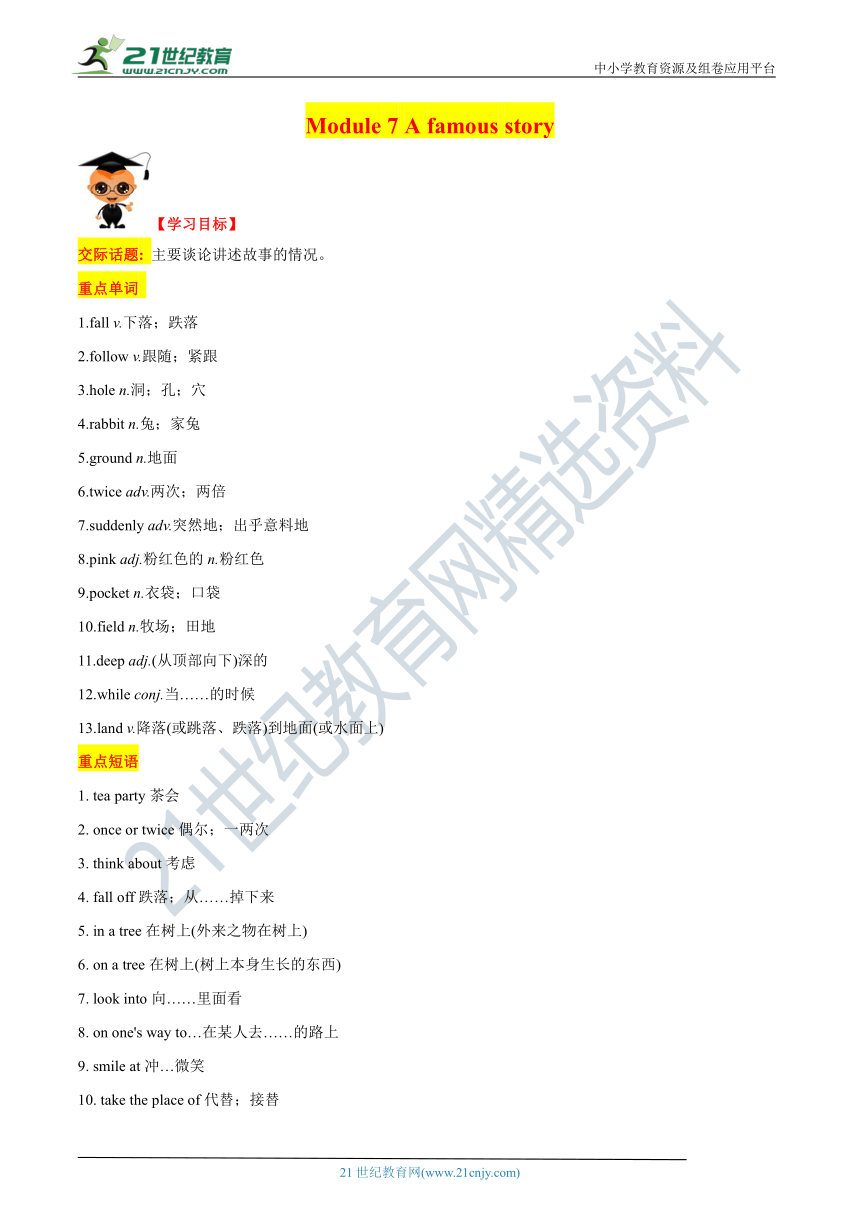 | |
| 格式 | doc | ||
| 文件大小 | 1.6MB | ||
| 资源类型 | 试卷 | ||
| 版本资源 | 外研版 | ||
| 科目 | 英语 | ||
| 更新时间 | 2021-08-13 10:22:55 | ||
图片预览

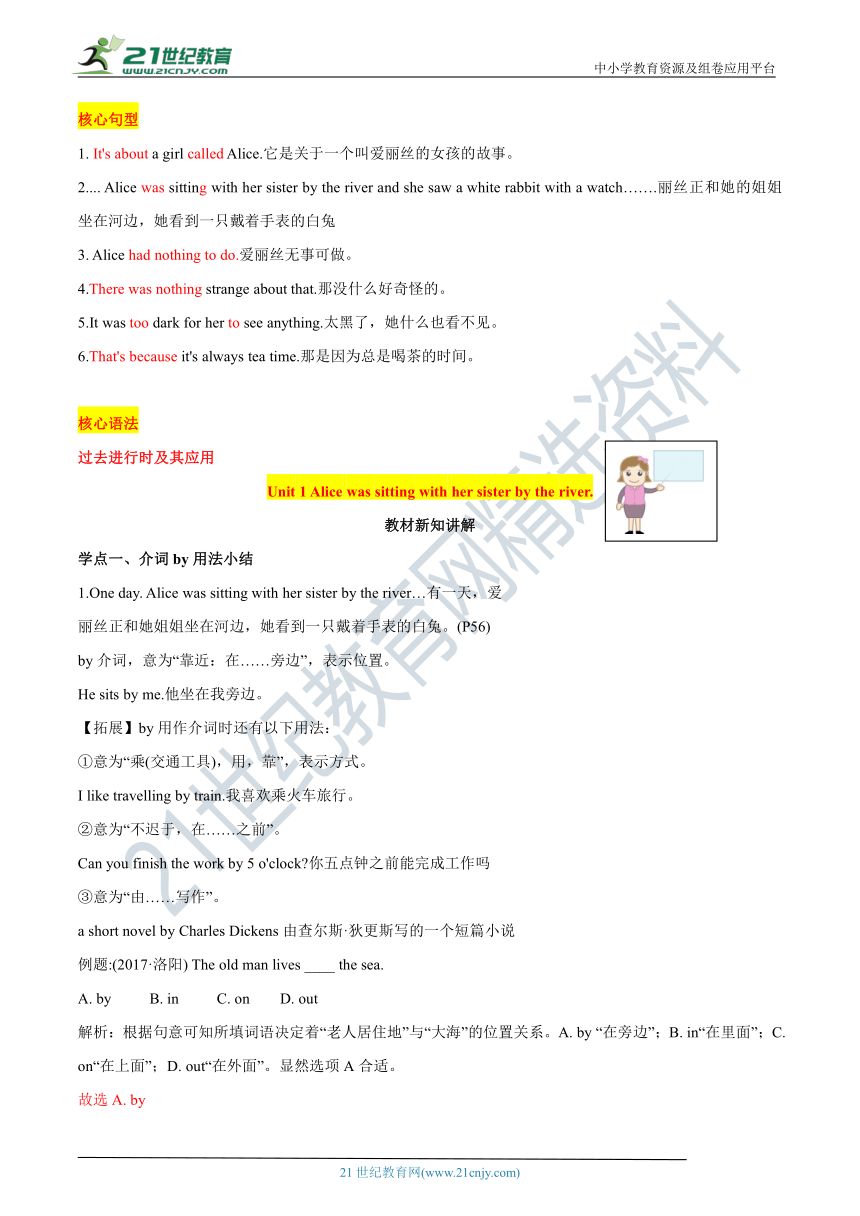
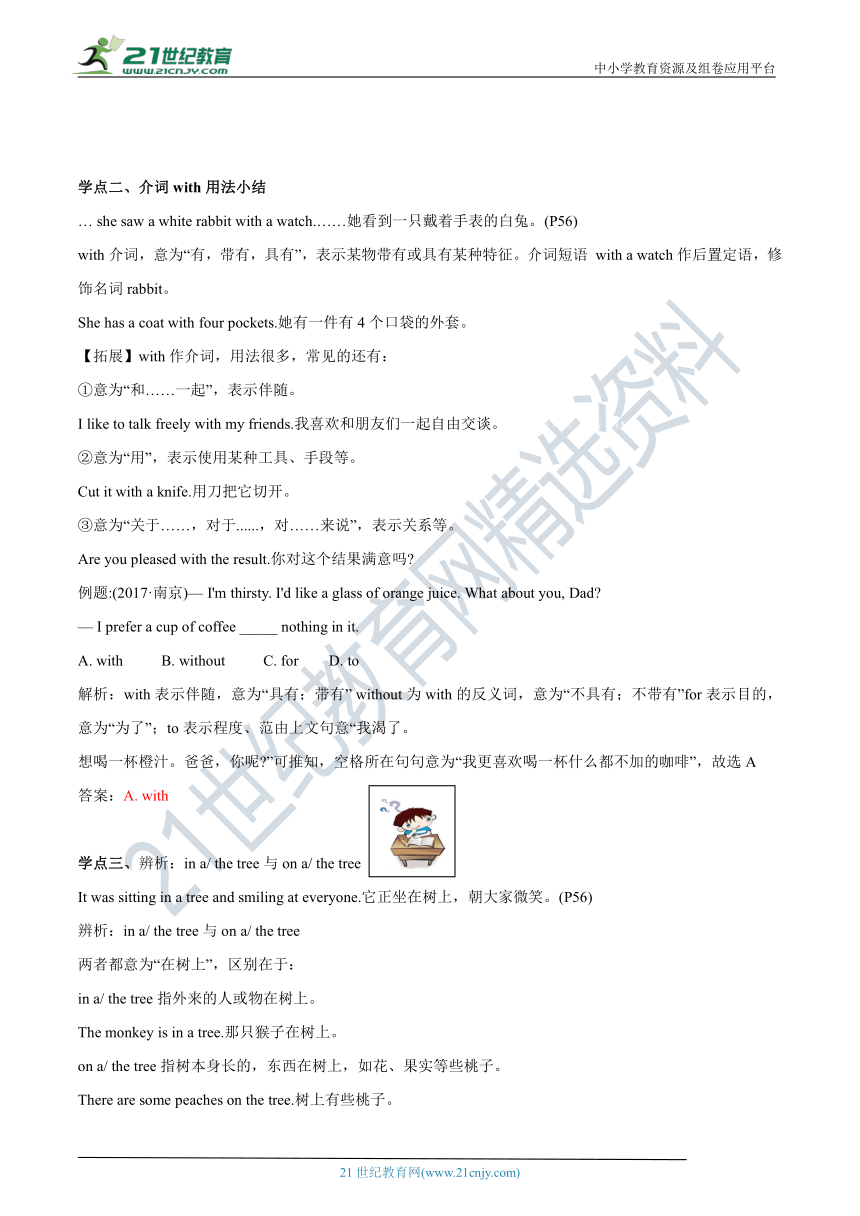
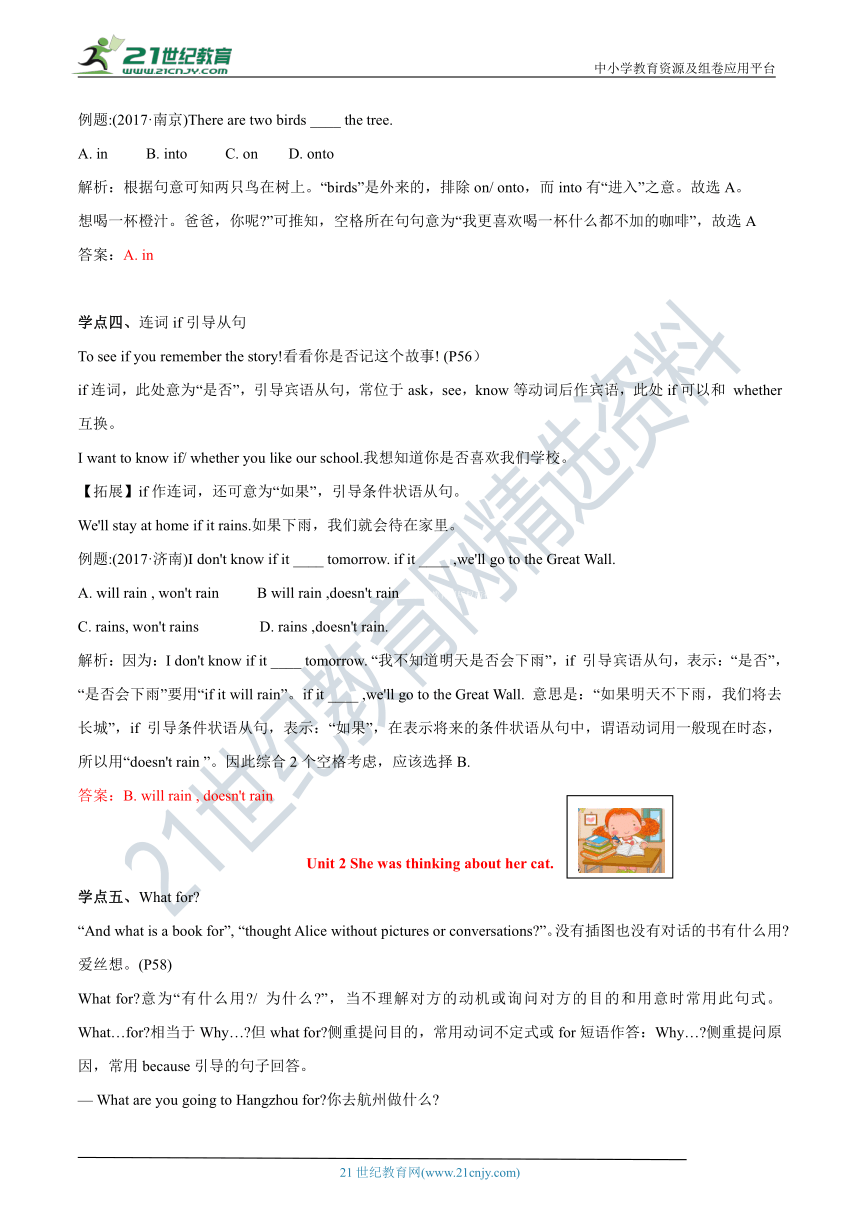
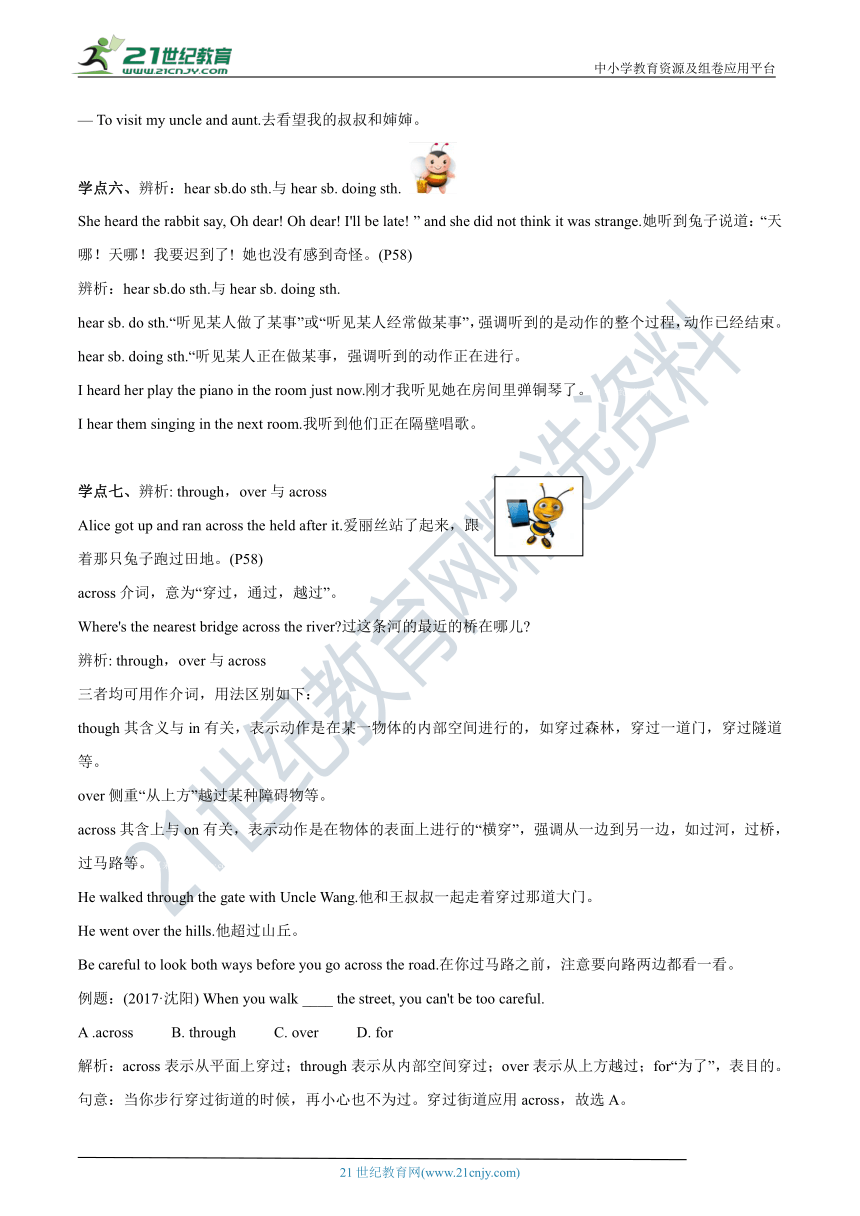
文档简介
中小学教育资源及组卷应用平台
Module 7 A famous story
【学习目标】
交际话题: 主要谈论讲述故事的情况。
重点单词
1.fall v.下落;跌落
2.follow v.跟随;紧跟
3.hole n.洞;孔;穴
4.rabbit n.兔;家兔
5.ground n.地面
6.twice adv.两次;两倍
7.suddenly adv.突然地;出乎意料地
8.pink adj.粉红色的n.粉红色
9.pocket n.衣袋;口袋
10.field n.牧场;田地
11.deep adj.(从顶部向下)深的
12.while conj.当……的时候
13.land v.降落(或跳落、跌落)到地面(或水面上)
重点短语
1. tea party茶会
2. once or twice偶尔;一两次
3. think about考虑
4. fall off跌落;从……掉下来
5. in a tree在树上(外来之物在树上)
6. on a tree在树上(树上本身生长的东西)
7. look into向……里面看
8. on one's way to…在某人去……的路上
9. smile at冲…微笑
10. take the place of代替;接替
核心句型
1. It's about a girl called Alice.它是关于一个叫爱丽丝的女孩的故事。21cnjy.com
2.... Alice was _sittin_g with her sister by the river and she saw a white rabbit with a watch…….丽丝正和她的姐姐坐在河边,她看到一只戴着手表的白兔21*cnjy*com
3. Alice had nothing to do.爱丽丝无事可做。
4.There was nothing strange about that.那没什么好奇怪的。
5.It was too dark for her to see anything.太黑了,她什么也看不见。
6.That's because it's always tea time.那是因为总是喝茶的时间。
核心语法
过去进行时及其应用
Unit 1 Alice was sitting with her sister by the river.
教材新知讲解
学点一、介词by用法小结
1.One day. Alice was sitting with her sister by the river…有一天,爱
丽丝正和她姐姐坐在河边,她看到一只戴着手表的白兔。(P56)
by介词,意为“靠近:在……旁边”,表示位置。
He sits by me.他坐在我旁边。
【拓展】by用作介词时还有以下用法:
①意为“乘(交通工具),用,靠”,表示方式。
I like travelling by train.我喜欢乘火车旅行。
②意为“不迟于,在……之前”。
Can you finish the work by 5 o'clock?你五点钟之前能完成工作吗
③意为“由……写作”。
a short novel by Charles Dickens由查尔斯·狄更斯写的一个短篇小说
例题:(2017·洛阳) The old man lives ____ the sea.
A. by B. in C. on D. out
解析:根据句意可知_??????è??è????????_着“老人居住地”与“大海”的位置关系。A. by “在旁边”;B. in“在里面”;C. on“在上面”;D. out“在外面”。显然选项A合适。www-2-1-cnjy-com
故选A. by
学点二、介词with用法小结
… she saw a white rabbit with a watch.……她看到一只戴着手表的白兔。(P56)21*cnjy*com
with介词,意为“有,带有,具有”,表示某物带有或具有某种特征。介词短语 with a watch作后置定语,修饰名词rabbit。
She has a coat with four pockets.她有一件有4个口袋的外套。
【拓展】with作介词,用法很多,常见的还有:
①意为“和……一起”,表示伴随。
I like to talk freely with my friends.我喜欢和朋友们一起自由交谈。【来源:21·世纪·教育·网】
②意为“用”,表示使用某种工具、手段等。
Cut it with a knife.用刀把它切开。
③意为“关于……,对于......,对……来说”,表示关系等。
Are you pleased with the result.你对这个结果满意吗?
例题:(2017·南京)— _I'm_th_irsty. I'd like a glass of orange juice. What about you, Dad?
— I prefer a cup of coffee _____ nothing in it.
A. with B. without C. for D. to
解析:with表示伴随,_???????????·??????_带有” without为with的反义词,意为“不具有;不带有”for表示目的,意为“为了”;to表示程度、范由上文句意“我渴了。
想喝一杯橙汁。爸爸,你呢?”可推知,空格所在句句意为“我更喜欢喝一杯什么都不加的咖啡”,故选A
答案:A. with
学点三、辨析:in a/ the tree与on a/ the tree
It was sitting in a tree and smiling at everyone.它正坐在树上,朝大家微笑。(P56)
辨析:in a/ the tree与on a/ the tree
两者都意为“在树上”,区别在于:
in a/ the tree指外来的人或物在树上。
The monkey is in a tree.那只猴子在树上。
on a/ the tree指树本身长的,东西在树上,如花、果实等些桃子。
There are some peaches on the tree.树上有些桃子。
例题:(2017·南京)There are two birds ____ the tree.
A. in B. into C. on D. onto
解析:根据句意可知两只鸟在树上。“birds”是外来的,排除on/ onto,而into有“进入”之意。故选A。
想喝一杯橙汁。爸爸,你呢?”可推知,空格所在句句意为“我更喜欢喝一杯什么都不加的咖啡”,故选A
答案:A. in
学点四、连词if引导从句
To see if you remember the story!看看你是否记这个故事! (P56)www.21-cn-jy.com
if连词,此处意为“是否”,引导宾语从句,常位于ask,see,know等动词后作宾语,此处if可以和 whether互换。
I want to know if/ whether you like our school.我想知道你是否喜欢我们学校。
【拓展】if作连词,还可意为“如果”,引导条件状语从句。
We'll stay at home if it rains.如果下雨,我们就会待在家里。
例题:(2017·济南)I__don't_ know if it ____ tomorrow. if it ____ ,we'll go to the Great Wall.
A. will rain , won't rain B will rain ,doesn't rain 21世纪教育网版权所有
C. rains, won't rains D. rains ,doesn't rain.
解析:因为:I don't kn_ow_if__it ____ tomorrow. “我不知道明天是否会下雨”,if 引导宾语从句,表示:“是否”,“是否会下雨”要用“if it will rain”。if it ____ ,we'll go to the Great Wall. 意思是:“如果明天不下雨,我们将去长城”,if 引导条件状语从句,表示:“如果”,在表示将来的条件状语从句中,谓语动词用一般现在时态,所以用“doesn't rain ”。因此综合2个空格考虑,应该选择B.
答案:B. will rain , doesn't rain
Unit 2 She was thinking about her cat.
学点五、What for?
“And what is a__book__for”, “thought Alice without pictures or conversations?”。没有插图也没有对话的书有什么用?爱丝想。(P58)
What for?意为“_???????????¨?/_ 为什么?”,当不理解对方的动机或询问对方的目的和用意时常用此句式。What…for?相当于Why…?但what for?侧重提问目的,常用动词不定式或for短语作答:Why…?侧重提问原因,常用because引导的句子回答。
— What are you going to Hangzhou for?你去航州做什么?
— To visit my uncle and aunt.去看望我的叔叔和婶婶。
学点六、辨析:hear sb.do sth.与hear sb. doing sth.
She heard__the_r_abbit say, Oh dear! Oh dear! I'll be late! ” and she did not think it was strange.她听到兔子说道:“天哪!天哪!我要迟到了! 她也没有感到奇怪。(P58)
辨析:hear sb.do sth.与hear sb. doing sth.
hear sb. do sth.“听见某人做了某事”或“听见某人经常做某事”,强调听到的是动作的整个过程,动作已经结束。
hear sb. doing sth.“听见某人正在做某事,强调听到的动作正在进行。
I heard her play the piano in the room just now.刚才我听见她在房间里弹铜琴了。21·世纪*教育网
I hear them singing in the next room.我听到他们正在隔壁唱歌。
学点七、辨析: through,over与across
Alice got up and ran across the held after it.爱丽丝站了起来,跟
着那只兔子跑过田地。(P58)
across介词,意为“穿过,通过,越过”。
Where's the nearest bridge across the river?过这条河的最近的桥在哪儿?
辨析: through,over与across
三者均可用作介词,用法区别如下:
though其含义与in有关,表示动作是在某一物体的内部空间进行的,如穿过森林,穿过一道门,穿过隧道等。2-1-c-n-j-y
over侧重“从上方”越过某种障碍物等。
across其含上与on有关,表示动作是在物体的表面上进行的“横穿”,强调从一边到另一边,如过河,过桥,过马路等。【来源:21cnj*y.co*m】
He walked through the gate with Uncle Wang.他和王叔叔一起走着穿过那道大门。【版权所有:21教育】
He went over the hills.他超过山丘。
Be careful to__look__both ways before you go across the road.在你过马路之前,注意要向路两边都看一看。
例题:(2017·沈阳) When you walk ____ the street, you can't be too careful.
A .across B. through C. over D. for
解析:acro_ssè?¨?¤???????_面上穿过;through表示从内部空间穿过;over表示从上方越过;for“为了”,表目的。句意:当你步行穿过街道的时候,再小心也不为过。穿过街道应用across,故选A。
答案: A .across
学点八、固定搭配too…to的应用
7. It was too dark for her to see anything.她什么也着不见。(P58)
too…to是一个固定搭配,意为“太……而不能……”,too为副词,后跟形容词或副词的原级,to是动间不定式符号,后跟动词原形。
The meat is too salty to eat.这肉太咸了,没法吃。
It's never too late to learn.活到老,学到老。
【拓展】①to_o...to_…结构可以和so…that…(如此……以至于……)结构互换。但that后的从句要用否定形式。
She?is?too?young?to?go?to?school.?= She?is?so young?that?she?can'?t?go?to?school.她太小了不能去上学。
②too…to…结构还可以与…?enough?to…结构互换,但?enough前面的形容词或副
词应是too后面的形容词或副词的反义词,且含有…?enough to…结构的句子须用
否定形式。
The?problem_??is??to_o?hard?to?work?out.=The problem?isn't?easy?enough?to work?out.这
个问题太难而不能解决。
例题:(2017·信阳)The box is too heavy ____ the little boy ____ carry.21·cn·jy·com
A.?to; for B.??to; to C.??for; for D.??for; to
too...to...“太....以至于不能....”是固定搭配。在"too...to"结构中加上一个for sb./sth.,以提示动词不定式(to carry)的逻辑主语起到一定的_é??????????¨_,即限制不定式(to carry)所表示的动作行为(carry)只是就它的逻辑主语(the little boy)而言的。故选D。
答案:D.??for; to
学点九、连词while的用法
While?she?wa_s??fall_ing,?she?was?thinking?about her?cat, Dinah.当她往下坠落时,她在想她的猫,黛娜。(P58)
while此处用作连词,意为“当……的时候”,可表示主句动作发生在从句动作发生的过程中,也可表示主句动作和从句动作同时发生或进行。
While?he?was?eating,?Tom?called?him.他正在吃饭时,汤姆给他打电话了。
注意:while引导的时间状语从句表示一种状态或延续性的动作,句中必须用延续性动词或表示状态的动词,不能用非延续性动词。
We?visited?the?Great?Wall?while?we?were?in Beijing.我们在北京的时候游览了长城。
(2017·南京)— When?did?the?classroom?have?a?power?cut?
— This?morning,?while?we ____ a?physics lesson.
A.?have?had B.?were?having C.?are?having D.?will?have
解析:while意为“当…的时候”,常与进行时态连用,排除A、D两项。问句时态是一般过去时,由此可推断“上物理课”这一动作也发生在过去,再排除C项。结合句意“教室什么时候停的电?”,“今天上午,当我们正在上物理课的时候”可知选B。
答案:B.?were?having
学点十、连词or的应用
Or you'll be asleep again before it's done.否则,在讲完之前你又会睡着的。(P62)21教育名师原创作品
or连词,意为“否则,要不然”,用于警告或忠告,常用于“析使句+or+陈述句”的结构中。
Hurry up, or we'll be late for school.快点儿,否则我们上学会迟到的。
例题:(2017·广州)Be careful! Don't walk on the grass, ____ it will "cry”.
A. and B. but C. or D. so
解析:and意为“和,又”;b_ut????????????_是”;or“或者,否则”;so意为“因此,所以”。由前部分句意“小心!不要在草地上走”和后部分“它将会哭”可知此处应用or“否则”,故选C。
答案:C. or
单元语法盘点
过去进行时(一)
1.含义:过去进行时表示在过去某一时刻正在进行的动作
或过去某一段时间内一直进行的动作。
2.构成:was/ were+动词的现在分词
注意:主语是第一人称单数和第三人称单数时用was,其余的都用were。
3.基本句型:
肯定句:主语+ was/ were+动词的现在分词+其他。
She was playing the piano at 8 am. yesterday.昨天早上8点她正在弹钢琴。
否定句:主语+ was/ were + not+动词的现在分词+其他。
We weren’t listening to music at that time.那时我们没有在听音乐。
一般疑问句及其回答:
Was/Were+主语+_??¨è???????°??¨???_词+其他? 肯定回答:Yes, 主语+was/were。否定回答:No, 主语+ wasn’t/ weren't。
— Were you working on the farm at that moment?那时你们正在农场工作吗?
— Yes, we were/ No, we weren't。
特殊疑问句:
疑问词(非主语) + 一般疑问句?
What were you doing at this time last night?昨天晚上这个时候你在做什么?
疑问词(主语)+ was/were+动词的现在分词+其他?
Who was singing at that time?那时谁在唱歌?
4. 常用的时间状语:at th_at_tim_e(在那时),at this time yesterday(在昨天的这个时候),at 6 am yesterday(在昨天上午6点),when+一般过去时的句子(当......时)等。
He was watching TV at that time.那时他正在看电视。
When I got home, my mother was cooking.当我到家时,我妈妈正在做饭。
5. 过去进行时与一般过去时的区别:
过去进行时表示过去某一时刻或某时间段内正在进行的动作,时间状语表示的时间比较具体。
She was playing computer games at 4 pm yesterday.昨天下午4点她正在玩电脑游戏。
一般过去时表示过去发生的动作或存在的状态,时间状语表示的时间不太具体。
She played computer games yesterday.昨天她玩电脑游戏了。
例题1:(2018·南通)My mother _____ some washing when the telephone rang.【出处:21教育名师】
A. does B. did C. is doing D. was doing
解析:本句是含时间状语从句的主_????¤?????????????_句用了一般过去时,所以推知主句动作也发生在过去,应用过去的某种时态,排除A、C两项。结合选项知句意为“当电话铃响的时候,我母亲正在洗衣服”。故应用过去进行时,选D。
答案:D. was doing
例题2:It ____ heavily at this time last night.
A. rains B. will rain C. was raining D. is raining
解析:由时间状语at this time last night知,用过去进行时。故选C。
答案:C. was raining
例题3:—Why didn't you go to the zoo with us this afternoon?21教育网
— Because I ____ at the station for my uncle from Beijing.
A. was waiting B. have waited C. am waiting D. will wait
解析:由问句句意“今天下午你为什么没和我们一起去动?”知,答语意为“因为我那时正在车站等侯我来自北京的叔叔”。故用过去进行时。选A。
答案:A. was waiting
核心素养解读
在我们上小学的时候,我们在语文的课堂中就接触了很多的寓言故事,其实不
光我们汉语有寓言故事,在英文中也有许多寓言故事。有时候看看一些英语寓言故
事短文,能在里面学到很多的哲理知识,对自己人生的帮助极大。下面欣赏一下大
家总都熟悉的一篇英语寓言故事吧!
The hare and the tortoise
The hare _was_on_ce boasting(夸耀)of his speed before the other animals. "I have never been beaten," he said, "when I run at full speed, no one is faster than me."2·1·c·n·j·y
The tortois_e_said_ quietly, "I will race with you." "That is a good joke," said the hare. "I could dance around you the whole way."
The race sta_rted.__The hare darted(急冲)almost out of sight at once. He soon stopped and lay down to have a nap.
The torto_ise_pl_odded on and on. When the hare awoke from his nap, he saw the tortoise was near the finish line, and that he had lost the race.
读后小测试:
1. The hare said that he have never been beaten.
A. been beaten B. was beaten C. be beat D. beats
解析:由句意“野兔说他从来没被打败过”知,语态是表示被动的,由于主句是一般过去时,从句用过去完成时被动语态。故选A。
答案:A. been beaten
2. No one is faster than me.(变成最高级形式)
解析:由句意“没人能比我快。可知“我是所有中最快的一个”,所以原句可改为“I’m the fastest of all.”
3.After a while, what did he do?
解析:由句子“He soon__stopp_ed and lay down to have a nap.”可知,“一会儿之后,他躺下来小睡一会儿。”所以答案为“(After a while,)he lay down to have a nap.”
_21?????????è?????(www.21cnjy.com)_
Module 7 A famous story
【学习目标】
交际话题: 主要谈论讲述故事的情况。
重点单词
1.fall v.下落;跌落
2.follow v.跟随;紧跟
3.hole n.洞;孔;穴
4.rabbit n.兔;家兔
5.ground n.地面
6.twice adv.两次;两倍
7.suddenly adv.突然地;出乎意料地
8.pink adj.粉红色的n.粉红色
9.pocket n.衣袋;口袋
10.field n.牧场;田地
11.deep adj.(从顶部向下)深的
12.while conj.当……的时候
13.land v.降落(或跳落、跌落)到地面(或水面上)
重点短语
1. tea party茶会
2. once or twice偶尔;一两次
3. think about考虑
4. fall off跌落;从……掉下来
5. in a tree在树上(外来之物在树上)
6. on a tree在树上(树上本身生长的东西)
7. look into向……里面看
8. on one's way to…在某人去……的路上
9. smile at冲…微笑
10. take the place of代替;接替
核心句型
1. It's about a girl called Alice.它是关于一个叫爱丽丝的女孩的故事。21cnjy.com
2.... Alice was _sittin_g with her sister by the river and she saw a white rabbit with a watch…….丽丝正和她的姐姐坐在河边,她看到一只戴着手表的白兔21*cnjy*com
3. Alice had nothing to do.爱丽丝无事可做。
4.There was nothing strange about that.那没什么好奇怪的。
5.It was too dark for her to see anything.太黑了,她什么也看不见。
6.That's because it's always tea time.那是因为总是喝茶的时间。
核心语法
过去进行时及其应用
Unit 1 Alice was sitting with her sister by the river.
教材新知讲解
学点一、介词by用法小结
1.One day. Alice was sitting with her sister by the river…有一天,爱
丽丝正和她姐姐坐在河边,她看到一只戴着手表的白兔。(P56)
by介词,意为“靠近:在……旁边”,表示位置。
He sits by me.他坐在我旁边。
【拓展】by用作介词时还有以下用法:
①意为“乘(交通工具),用,靠”,表示方式。
I like travelling by train.我喜欢乘火车旅行。
②意为“不迟于,在……之前”。
Can you finish the work by 5 o'clock?你五点钟之前能完成工作吗
③意为“由……写作”。
a short novel by Charles Dickens由查尔斯·狄更斯写的一个短篇小说
例题:(2017·洛阳) The old man lives ____ the sea.
A. by B. in C. on D. out
解析:根据句意可知_??????è??è????????_着“老人居住地”与“大海”的位置关系。A. by “在旁边”;B. in“在里面”;C. on“在上面”;D. out“在外面”。显然选项A合适。www-2-1-cnjy-com
故选A. by
学点二、介词with用法小结
… she saw a white rabbit with a watch.……她看到一只戴着手表的白兔。(P56)21*cnjy*com
with介词,意为“有,带有,具有”,表示某物带有或具有某种特征。介词短语 with a watch作后置定语,修饰名词rabbit。
She has a coat with four pockets.她有一件有4个口袋的外套。
【拓展】with作介词,用法很多,常见的还有:
①意为“和……一起”,表示伴随。
I like to talk freely with my friends.我喜欢和朋友们一起自由交谈。【来源:21·世纪·教育·网】
②意为“用”,表示使用某种工具、手段等。
Cut it with a knife.用刀把它切开。
③意为“关于……,对于......,对……来说”,表示关系等。
Are you pleased with the result.你对这个结果满意吗?
例题:(2017·南京)— _I'm_th_irsty. I'd like a glass of orange juice. What about you, Dad?
— I prefer a cup of coffee _____ nothing in it.
A. with B. without C. for D. to
解析:with表示伴随,_???????????·??????_带有” without为with的反义词,意为“不具有;不带有”for表示目的,意为“为了”;to表示程度、范由上文句意“我渴了。
想喝一杯橙汁。爸爸,你呢?”可推知,空格所在句句意为“我更喜欢喝一杯什么都不加的咖啡”,故选A
答案:A. with
学点三、辨析:in a/ the tree与on a/ the tree
It was sitting in a tree and smiling at everyone.它正坐在树上,朝大家微笑。(P56)
辨析:in a/ the tree与on a/ the tree
两者都意为“在树上”,区别在于:
in a/ the tree指外来的人或物在树上。
The monkey is in a tree.那只猴子在树上。
on a/ the tree指树本身长的,东西在树上,如花、果实等些桃子。
There are some peaches on the tree.树上有些桃子。
例题:(2017·南京)There are two birds ____ the tree.
A. in B. into C. on D. onto
解析:根据句意可知两只鸟在树上。“birds”是外来的,排除on/ onto,而into有“进入”之意。故选A。
想喝一杯橙汁。爸爸,你呢?”可推知,空格所在句句意为“我更喜欢喝一杯什么都不加的咖啡”,故选A
答案:A. in
学点四、连词if引导从句
To see if you remember the story!看看你是否记这个故事! (P56)www.21-cn-jy.com
if连词,此处意为“是否”,引导宾语从句,常位于ask,see,know等动词后作宾语,此处if可以和 whether互换。
I want to know if/ whether you like our school.我想知道你是否喜欢我们学校。
【拓展】if作连词,还可意为“如果”,引导条件状语从句。
We'll stay at home if it rains.如果下雨,我们就会待在家里。
例题:(2017·济南)I__don't_ know if it ____ tomorrow. if it ____ ,we'll go to the Great Wall.
A. will rain , won't rain B will rain ,doesn't rain 21世纪教育网版权所有
C. rains, won't rains D. rains ,doesn't rain.
解析:因为:I don't kn_ow_if__it ____ tomorrow. “我不知道明天是否会下雨”,if 引导宾语从句,表示:“是否”,“是否会下雨”要用“if it will rain”。if it ____ ,we'll go to the Great Wall. 意思是:“如果明天不下雨,我们将去长城”,if 引导条件状语从句,表示:“如果”,在表示将来的条件状语从句中,谓语动词用一般现在时态,所以用“doesn't rain ”。因此综合2个空格考虑,应该选择B.
答案:B. will rain , doesn't rain
Unit 2 She was thinking about her cat.
学点五、What for?
“And what is a__book__for”, “thought Alice without pictures or conversations?”。没有插图也没有对话的书有什么用?爱丝想。(P58)
What for?意为“_???????????¨?/_ 为什么?”,当不理解对方的动机或询问对方的目的和用意时常用此句式。What…for?相当于Why…?但what for?侧重提问目的,常用动词不定式或for短语作答:Why…?侧重提问原因,常用because引导的句子回答。
— What are you going to Hangzhou for?你去航州做什么?
— To visit my uncle and aunt.去看望我的叔叔和婶婶。
学点六、辨析:hear sb.do sth.与hear sb. doing sth.
She heard__the_r_abbit say, Oh dear! Oh dear! I'll be late! ” and she did not think it was strange.她听到兔子说道:“天哪!天哪!我要迟到了! 她也没有感到奇怪。(P58)
辨析:hear sb.do sth.与hear sb. doing sth.
hear sb. do sth.“听见某人做了某事”或“听见某人经常做某事”,强调听到的是动作的整个过程,动作已经结束。
hear sb. doing sth.“听见某人正在做某事,强调听到的动作正在进行。
I heard her play the piano in the room just now.刚才我听见她在房间里弹铜琴了。21·世纪*教育网
I hear them singing in the next room.我听到他们正在隔壁唱歌。
学点七、辨析: through,over与across
Alice got up and ran across the held after it.爱丽丝站了起来,跟
着那只兔子跑过田地。(P58)
across介词,意为“穿过,通过,越过”。
Where's the nearest bridge across the river?过这条河的最近的桥在哪儿?
辨析: through,over与across
三者均可用作介词,用法区别如下:
though其含义与in有关,表示动作是在某一物体的内部空间进行的,如穿过森林,穿过一道门,穿过隧道等。2-1-c-n-j-y
over侧重“从上方”越过某种障碍物等。
across其含上与on有关,表示动作是在物体的表面上进行的“横穿”,强调从一边到另一边,如过河,过桥,过马路等。【来源:21cnj*y.co*m】
He walked through the gate with Uncle Wang.他和王叔叔一起走着穿过那道大门。【版权所有:21教育】
He went over the hills.他超过山丘。
Be careful to__look__both ways before you go across the road.在你过马路之前,注意要向路两边都看一看。
例题:(2017·沈阳) When you walk ____ the street, you can't be too careful.
A .across B. through C. over D. for
解析:acro_ssè?¨?¤???????_面上穿过;through表示从内部空间穿过;over表示从上方越过;for“为了”,表目的。句意:当你步行穿过街道的时候,再小心也不为过。穿过街道应用across,故选A。
答案: A .across
学点八、固定搭配too…to的应用
7. It was too dark for her to see anything.她什么也着不见。(P58)
too…to是一个固定搭配,意为“太……而不能……”,too为副词,后跟形容词或副词的原级,to是动间不定式符号,后跟动词原形。
The meat is too salty to eat.这肉太咸了,没法吃。
It's never too late to learn.活到老,学到老。
【拓展】①to_o...to_…结构可以和so…that…(如此……以至于……)结构互换。但that后的从句要用否定形式。
She?is?too?young?to?go?to?school.?= She?is?so young?that?she?can'?t?go?to?school.她太小了不能去上学。
②too…to…结构还可以与…?enough?to…结构互换,但?enough前面的形容词或副
词应是too后面的形容词或副词的反义词,且含有…?enough to…结构的句子须用
否定形式。
The?problem_??is??to_o?hard?to?work?out.=The problem?isn't?easy?enough?to work?out.这
个问题太难而不能解决。
例题:(2017·信阳)The box is too heavy ____ the little boy ____ carry.21·cn·jy·com
A.?to; for B.??to; to C.??for; for D.??for; to
too...to...“太....以至于不能....”是固定搭配。在"too...to"结构中加上一个for sb./sth.,以提示动词不定式(to carry)的逻辑主语起到一定的_é??????????¨_,即限制不定式(to carry)所表示的动作行为(carry)只是就它的逻辑主语(the little boy)而言的。故选D。
答案:D.??for; to
学点九、连词while的用法
While?she?wa_s??fall_ing,?she?was?thinking?about her?cat, Dinah.当她往下坠落时,她在想她的猫,黛娜。(P58)
while此处用作连词,意为“当……的时候”,可表示主句动作发生在从句动作发生的过程中,也可表示主句动作和从句动作同时发生或进行。
While?he?was?eating,?Tom?called?him.他正在吃饭时,汤姆给他打电话了。
注意:while引导的时间状语从句表示一种状态或延续性的动作,句中必须用延续性动词或表示状态的动词,不能用非延续性动词。
We?visited?the?Great?Wall?while?we?were?in Beijing.我们在北京的时候游览了长城。
(2017·南京)— When?did?the?classroom?have?a?power?cut?
— This?morning,?while?we ____ a?physics lesson.
A.?have?had B.?were?having C.?are?having D.?will?have
解析:while意为“当…的时候”,常与进行时态连用,排除A、D两项。问句时态是一般过去时,由此可推断“上物理课”这一动作也发生在过去,再排除C项。结合句意“教室什么时候停的电?”,“今天上午,当我们正在上物理课的时候”可知选B。
答案:B.?were?having
学点十、连词or的应用
Or you'll be asleep again before it's done.否则,在讲完之前你又会睡着的。(P62)21教育名师原创作品
or连词,意为“否则,要不然”,用于警告或忠告,常用于“析使句+or+陈述句”的结构中。
Hurry up, or we'll be late for school.快点儿,否则我们上学会迟到的。
例题:(2017·广州)Be careful! Don't walk on the grass, ____ it will "cry”.
A. and B. but C. or D. so
解析:and意为“和,又”;b_ut????????????_是”;or“或者,否则”;so意为“因此,所以”。由前部分句意“小心!不要在草地上走”和后部分“它将会哭”可知此处应用or“否则”,故选C。
答案:C. or
单元语法盘点
过去进行时(一)
1.含义:过去进行时表示在过去某一时刻正在进行的动作
或过去某一段时间内一直进行的动作。
2.构成:was/ were+动词的现在分词
注意:主语是第一人称单数和第三人称单数时用was,其余的都用were。
3.基本句型:
肯定句:主语+ was/ were+动词的现在分词+其他。
She was playing the piano at 8 am. yesterday.昨天早上8点她正在弹钢琴。
否定句:主语+ was/ were + not+动词的现在分词+其他。
We weren’t listening to music at that time.那时我们没有在听音乐。
一般疑问句及其回答:
Was/Were+主语+_??¨è???????°??¨???_词+其他? 肯定回答:Yes, 主语+was/were。否定回答:No, 主语+ wasn’t/ weren't。
— Were you working on the farm at that moment?那时你们正在农场工作吗?
— Yes, we were/ No, we weren't。
特殊疑问句:
疑问词(非主语) + 一般疑问句?
What were you doing at this time last night?昨天晚上这个时候你在做什么?
疑问词(主语)+ was/were+动词的现在分词+其他?
Who was singing at that time?那时谁在唱歌?
4. 常用的时间状语:at th_at_tim_e(在那时),at this time yesterday(在昨天的这个时候),at 6 am yesterday(在昨天上午6点),when+一般过去时的句子(当......时)等。
He was watching TV at that time.那时他正在看电视。
When I got home, my mother was cooking.当我到家时,我妈妈正在做饭。
5. 过去进行时与一般过去时的区别:
过去进行时表示过去某一时刻或某时间段内正在进行的动作,时间状语表示的时间比较具体。
She was playing computer games at 4 pm yesterday.昨天下午4点她正在玩电脑游戏。
一般过去时表示过去发生的动作或存在的状态,时间状语表示的时间不太具体。
She played computer games yesterday.昨天她玩电脑游戏了。
例题1:(2018·南通)My mother _____ some washing when the telephone rang.【出处:21教育名师】
A. does B. did C. is doing D. was doing
解析:本句是含时间状语从句的主_????¤?????????????_句用了一般过去时,所以推知主句动作也发生在过去,应用过去的某种时态,排除A、C两项。结合选项知句意为“当电话铃响的时候,我母亲正在洗衣服”。故应用过去进行时,选D。
答案:D. was doing
例题2:It ____ heavily at this time last night.
A. rains B. will rain C. was raining D. is raining
解析:由时间状语at this time last night知,用过去进行时。故选C。
答案:C. was raining
例题3:—Why didn't you go to the zoo with us this afternoon?21教育网
— Because I ____ at the station for my uncle from Beijing.
A. was waiting B. have waited C. am waiting D. will wait
解析:由问句句意“今天下午你为什么没和我们一起去动?”知,答语意为“因为我那时正在车站等侯我来自北京的叔叔”。故用过去进行时。选A。
答案:A. was waiting
核心素养解读
在我们上小学的时候,我们在语文的课堂中就接触了很多的寓言故事,其实不
光我们汉语有寓言故事,在英文中也有许多寓言故事。有时候看看一些英语寓言故
事短文,能在里面学到很多的哲理知识,对自己人生的帮助极大。下面欣赏一下大
家总都熟悉的一篇英语寓言故事吧!
The hare and the tortoise
The hare _was_on_ce boasting(夸耀)of his speed before the other animals. "I have never been beaten," he said, "when I run at full speed, no one is faster than me."2·1·c·n·j·y
The tortois_e_said_ quietly, "I will race with you." "That is a good joke," said the hare. "I could dance around you the whole way."
The race sta_rted.__The hare darted(急冲)almost out of sight at once. He soon stopped and lay down to have a nap.
The torto_ise_pl_odded on and on. When the hare awoke from his nap, he saw the tortoise was near the finish line, and that he had lost the race.
读后小测试:
1. The hare said that he have never been beaten.
A. been beaten B. was beaten C. be beat D. beats
解析:由句意“野兔说他从来没被打败过”知,语态是表示被动的,由于主句是一般过去时,从句用过去完成时被动语态。故选A。
答案:A. been beaten
2. No one is faster than me.(变成最高级形式)
解析:由句意“没人能比我快。可知“我是所有中最快的一个”,所以原句可改为“I’m the fastest of all.”
3.After a while, what did he do?
解析:由句子“He soon__stopp_ed and lay down to have a nap.”可知,“一会儿之后,他躺下来小睡一会儿。”所以答案为“(After a while,)he lay down to have a nap.”
_21?????????è?????(www.21cnjy.com)_
同课章节目录
- Module 1 How to learn English
- Unit 1 Let's try to speak English as much as possi
- Unit 2 You should smile at her.
- Unit 3 Language in use .
- Module 2 My home town and my country
- Unit 1 It's taller than many other buildings.
- Unit 2 Cambridge is a beautiful city in the east o
- Unit 3 Language in use .
- Module 3 Sports.
- Unit 1 Nothing is more exciting than playing tenni
- Unit 2 This year we training more carefully.
- Unit 3 Language in use .
- Module 4 Planes, ships and trains .
- Unit 1 He lives the farthest from school.
- Unit 2 What is the best way to travel.
- Unit 3 Language in use .
- Module 5 Lao She Teahouse.
- Unit 1 I wanted to see the Beijing Opera.
- Unit 2 It descibes the changes in Chinese society.
- Unit 3 Language in use .
- Module 6 Animals in danger.
- Unit 1 It allows people to get closer to them .
- Unit 2 The WWF is working hard to save them all.
- Unit 3 Language in use .
- Revision module A
- Module 7 A famous story
- Unit 1 Alice was sitting with her sister by the ri
- Unit 2 She was thinking about her cat.
- Unit 3 Language in use .
- Module 8 Accidents
- Unit 1 While the car were changing to red, a car s
- Unit 2 I was trying to pick it up when it bite me
- Unit 3 Language in use .
- Module 9 Population
- Unit 1 The population of China is about 1.37 billi
- Unit 2 Arnwick was a city with 200,000 people.
- Unit 3 Language in use .
- Module 10 The weathe
- Unit 1 It might snow.
- Unit 2 The weather is fine all year round.
- Unit 3 Language in use .
- Module 11 Way of life
- Unit 1 In China ,we open a gift later.
- Unit 2 In England, you usually drink tea with milk
- Unit 3 Language in use .
- Module 12 Help
- Unit 1 What should we do before help arrives?
- Unit 2 Stay away from windows and heavy furniture.
- Unit 3 Language in use .
- Revision module B
